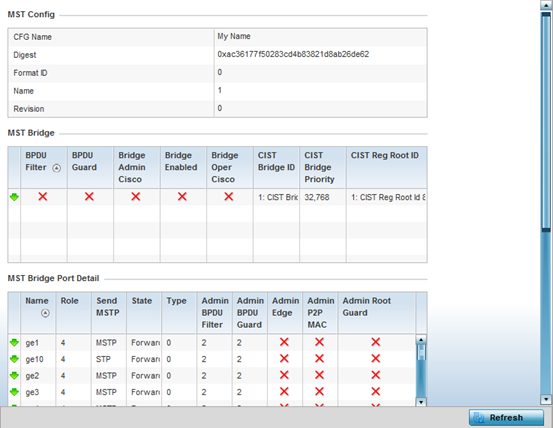MSTP
If there‘s just one VLAN in the access point managed network, a single spanning tree works fine. However, if the network contains more than one VLAN, the network topology defined by single STP would work, but it‘s possible to make better use of the alternate paths available by using an alternate spanning tree for different VLANs or groups of VLANs.
MSTP includes all of its spanning tree information in a single BPDU (Bridge Protocol Data Unit) format. BPDUs are used to exchange information bridge IDs and root path costs. Not only does this reduce the number of BPDUs required to communicate spanning tree information for each VLAN, but it also ensures backward compatibility with RSTP. MSTP encodes additional region information after the standard RSTP BPDU as well as a number of MSTI messages. Each MSTI messages conveys spanning tree information for each instance. Each instance can be assigned a number of configured VLANs. The frames assigned to these VLANs operate in this spanning tree instance whenever they are inside the MST region. To avoid conveying their entire VLAN to spanning tree mapping in each BPDU, the access point encodes an MD5 digest of their VLAN to an instance table in the MSTP BPDU. This digest is used by other MSTP supported devices to determine if the neighboring device is in the same MST region as itself.
To view a controller or service platform‘s MSTP statistics:
- Select the Statistics menu from the Web UI.
- Expand the System node from the navigation pane (on the left-hand side of the screen). The System node expands to display the RF Domains created within the managed network.
- Expand the RF Domain node.
- Select a Wireless Controller.
- Expand the Network menu from the left-hand side of the UI.
- Select MSTP. The stats is displayed in the right-hand pane.

The MST Config field displays the name assigned to the MSTP configuration, its digest, format ID, name and revision.
The MST Bridge field lists the filters and guards that have been enabled and whether Cisco interoperability if enabled.
The MST Bridge Port Detail field lists specific controller or service platform port status and their current state.
- Select Refresh to update the screen‘s statistics counters to their latest values.

